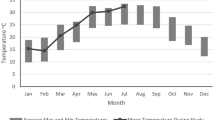Summary
The intrinsic rate of natural increase (r m) is calculated for 72 primate species, using Cole's (1954) equation. The value of r m relative to body mass is then calculated by use of allometric analysis. Both r mand relative r m are used to test the prediction that animals in unpredictable and/or harsh habitats will have a higher r mthan will those in more predictable and/or less harsh habitats. No significant link between habitat type and r mis found. However, correlations between ecology and relative r msuggest that relative r mis high in primate species living in more open habitats and low in species found in primary rainforest. Although there are few correlations between relative r m and climate parameters, those that are found suggest that variable climates, dry climates and hot climates will select for a high relative r m.
Similar content being viewed by others
References
Boyce MS (1979) Seasonality and patterns of natural selection for life histories. Am Nat 114:569–583
Boyce MS (1984) Restitution of r- and K-selection as a model of density-dependent natural selection. Annu Rev Ecol Syst 15:427–447
Bronson MT (1979) Altitudinal variation in the life history of the golden-mantled ground squirrel (Spermophilus lateralis) Ecology 60:272–279
Clutton-Brock TH, Harvey PH (1977) Primate ecology and social organisation. J Zool 183:1–39
Chism J, Rowell T, Olson D (1984) Life history patterns of female patas monkeys. In: Small MF (ed) Female Primates; Studies by women primatologists. Alan R Liss Inc., New York, pp 175–190
Cole LC (1954) The population consequences of life history phenomena. Q Rev Biol 29:103–137
Cords M (1987) Forest guenons and patas monkeys: male-male competition in one-male groups. In: Smuts BB, Cheney DL, Seyfarth RM, Wrangham RW, Struhsaker TT (eds) (1987) Primate societies. University of Chicago Press, Chicago and London, pp 98–111
Cords M, Rowell TE (1987) Birth intervals of Cercopithecus monkeys of the Kakamega Forest, Kenya. Primates 28:277–281
Environmental Science Services Administration (1955–1958) World Weather Records 1940–1950. (6 Volumes). Environmental Science Services Administration, Washington, DC
Environmental Science Services Administration (1965–1968) World Weather Records 1950–1960. (6 Volumes). Environmental Science Services Administration, Washington, DC
Fenchel T (1974) Intrinsic rate of natural of natural increase: the relationship with body size. Oecologia 14:317–326
Harvey PH, Clutton-Brock TH (1985) Life-history variation in primates. Evolution 39:559–581
Harvey PH and Mace GM (1982) Comparisons between taxa and adaptive trends: a problem of methodology. In: King's College Sociobiology Group (eds) Current Trends in Sociobiology. Cambridge University Press, Cambridge, UK, pp 343–362
Harvey PH, Martin RD, Clutton-Brock TH (1987) Life histories in comparative perspective. In: Smuts BB, Cheney DL, Seyfarth RM, Wrangham RW, Struhsaker TT (eds) (1987) Primate societies. University of Chicago Press, Chicago and London, pp 181–196
Hayssen V (1984) Basal metabolic rate and the intrinsic rate of natural increase: an empirical and theoretical reexamination. Oecologia 64:419–424
Hennemann WW III (1983) Relationship among body mass, metabolic rate and the intrinsic rate of natural increase in mammals. Oecologia 56:419–424
Hennemann WW III (1984) Basal metabolic rate and the intrinsic rate of natural increase: an empirical and theoretical reexamination. Oecologia 64:421–423
MacArthur RH, Wilson EO (1967) The Theory of Island Biogeography. Princeton University Press, Princeton
Nash LT (1983) Reproductive patterns in Galagos (Galago zanzibaricus and Galago garnetti) in relation to climatic variability. Am J Primatol 5:181–196
Pianka ER (1970) On r- and K-selection. Am Nat 104:592–597
Robinson JG, Redford KH (1986) Intrinsic rate of natural increase in Neotropical forest mammals: relationship to phylogeny and diet. Oecologia 68:516–520
Ross C (1988) The intrinsic rate of natural increase and reproductive effort in primates. J Zool 214:199–219
Ross C (1989) Life history strategies of primates. Unpubl. PhD thesis. University of London
Ross C (1991) Life history patterns of New World monkeys. Int J Primatol 12:498–502
Rowell TE, Richards JM (1979) Reproductive strategies of some African monkeys. J Mammal 60:58–69
Smuts BB, Cheney DL, Seyfarth RM, Wrangham RW, Struhsaker TT (eds) (1987) Primate societies. University of Chicago Press, Chicago and London Stearns SC (1976) Life-history tactics: a review of the ideas. Q Rev Biol 51:3–47
Stearns SC (1977) The evolution of life-history traits: a critique of the theory and a review of the data. Annu Rev Ecol Syst 8:145–171
Stearns SC (1983) The influence of size and phylogeny on patterns of covariation among life-history traits in the mammals. Oikos 41:173–187
Swihart RK (1984) Body size, breeding season length, and life history tactics of lagomorphs. Oikos 43:282–290
Wolfheim JH (1983) Primates of the World. Distribution, Abundance and Conservation. Harwood Academic Publishers, Chur
Zammuto RM, Miller JS (1985) Environmental predictability, variability, and Spermophilus columbianus life history over an elevational gradient. Ecology 66:1784–1794
Zeveloff S, Boyce MS (1988) Body size patterns in North American mammal faunas. In Boyce MS (ed) Evolution of Life Histories of Mammals: Theory and Pattern. Yale University Press, New Haven and London, pp 123–146
Author information
Authors and Affiliations
Rights and permissions
About this article
Cite this article
Ross, C. Environmental correlates of the intrinsic rate of natural increase in primates. Oecologia 90, 383–390 (1992). https://doi.org/10.1007/BF00317695
Received:
Accepted:
Issue Date:
DOI: https://doi.org/10.1007/BF00317695




